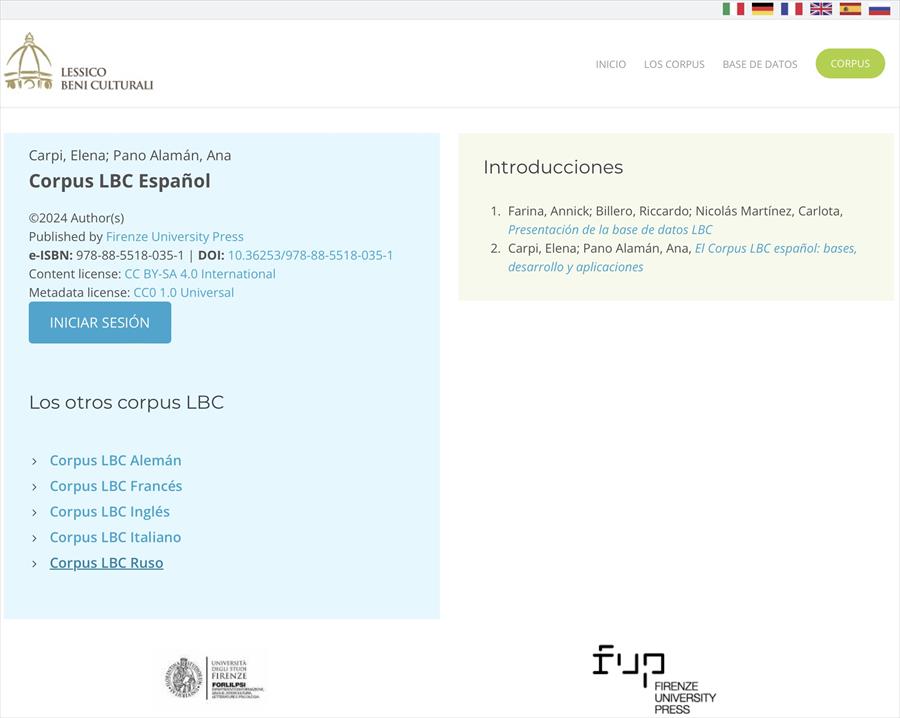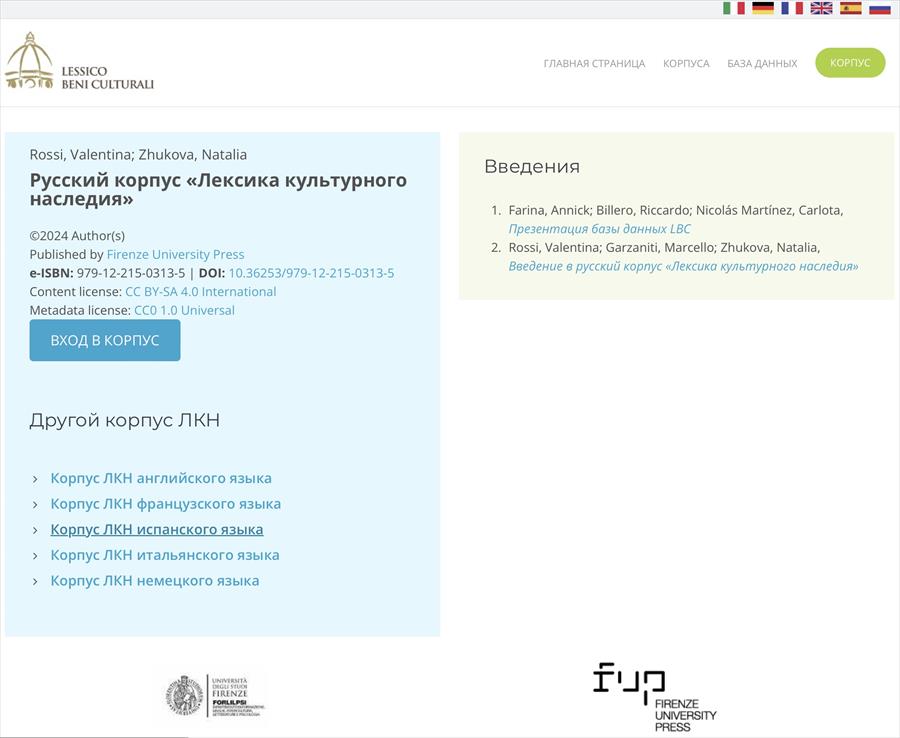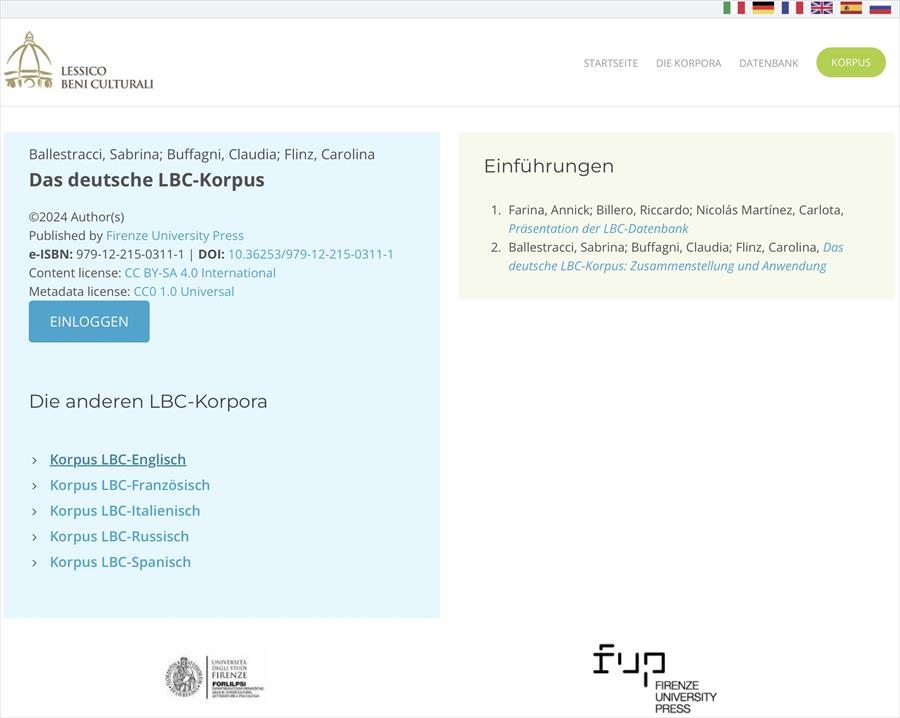Corpus LBC (Lessico dei Beni Culturali) Français
- Annick Farina,
The lemma gathers the essential entries in the field of artistic goods and includes place names and personal names strictly connected to Italian and Florentine art. It is a reference work, of great interest also for researchers of specialized vocabulary and extremely useful for translators and cultural operators.
The corpus used contains over a million words and constitutes, along with comparable corpora in French, German, Russian, English, and Spanish, the General LBC Corpus http://corpora.lessicobeniculturali.net. It is composed of texts of different types and genres from the Renaissance to the twentieth century and collects, alongside original language writings, also translations from other languages. It includes classic works dedicated to the Florentine and Italian artistic heritage, such as Giorgio Vasari's Vita and Benvenuto Cellini's Vite, technical texts like Andrea Palladio's I Quattro Libri dell'Architettura; famous historical-artistic writings by non-Italian authors, for example, Jacob Burckhardt's Geschichte der Renaissance in Italien or John Ruskin's Mornings in Florence, along with works by great writers dedicated to the Grand Tour in Italy, such as Stendhal's Promenade dans Rome, Goethe's Italienische Reise, etc. The list of sources used for each language is presented on the website.
By clicking on the words in the lemma, a window will open containing the list of concordances, as well as citations of the terms in the corpus sources, accompanied by an abbreviation that refers to the bibliographic indication of the originating text. The lemma includes about 2000 words of essential art lexicon and about 10,000 concordances that show their usage in context.
- Keywords:
- Multilingual Lexicon,
- Cultural Heritage,
- Lexicographic Research,
- Corpus,
- Digital Platform,
- DOI: 10.36253/979-12-215-0309-8
- Series: Lessico multilingue dei Beni Culturali
- Scientific Board
- Language: French
- Subjects: Linguistic Art
- View the website
-

- © 2024 Author(s)
- CC BY-SA 4.0
University of Florence, Italy - ORCID: 0000-0002-5148-0986
- Billero R. (2020), Cultural Heritage Lexicon: A Case Study. In Ana Pano Alamán, Valeria Zotti, The language of art and culture heritage: a plurilingual and digital perspective, Cambridge Scholars Publishing, pp. 86-103.
- Billero R., Nicolás Martínez M.C. (2017), Nuove risorse per la ricerca del lessico del patrimonio culturale: corpora multilingue LBC. In CHIMERA Romance Corpora and Linguistic Studies, Madrid, UAM, 4.2, pp. 203-216.
- Billero R., Carpi E. (2018), Corpora e terminologia artistica: il caso del corpus spagnolo LBC. In CHIMERA Romance Corpora and Linguistic Studies, Madrid, UAM, 5, no. 1, pp. 85-91.
- Carpi E. (2017), El lenguaje para fines artísticos: traducciones de tondo al español. In Alejandro Curado (ed.), LSP in Multi-disciplinary contexts of Teaching and Research. Papers from the 16th International AELFE Conference, vol. 3, pp. 79–84. DOI: 10.29007/wx3m
- Farina A., Nicolás Martínez C., Billero R. (eds.) (2020), I Corpora LBC, Firenze University Press, Firenze.
- Farina A., Flinz C. (2020), Analisi comparativa dei corpora LBC. La visione del patrimonio fiorentino francese e tedesco: l'esempio del Duomo. In Fernando Funari, Annick Farina (eds.), Le présent dans le passé / Past in Present/ Il passato nel presente, Firenze University Press, Firenze.
- Farina A., Billero R. (2018), Comparaison de corpus de langue « naturelle » et de langue « de traduction » : les bases de données textuelles LBC, un outil essentiel pour la création de fiches lexicographiques bilingues, JADT’18 Proceedings of the 14th International Conference on Statistical Analysis of Textual Data, UniversItalia, pp. 108-116.
- Farina A. (2016), Le portail lexicographique du Lessico plurilingue dei Beni Culturali, outil pour le professionnel, instrument de divulgation du savoir patrimonial et atelier didactique. In Publif@rum, n. 24, 2016. http://www.farum.it/publifarum/ezine_articles.php?art_id=335
- Garzaniti M. (2020), Il termine russo friag e le sue radici nelle relazioni culturali e artistiche fra la Russia e l’Italia. In Ana Pano Alamán, Valeria Zotti, The language of art and culture heritage: a plurilingual and digital perspective, Cambridge Scholars Publishing. pp 104-119.
- Publication Year: 2024
- eISBN: 979-12-215-0309-8
- Content License: CC BY-SA 4.0
- © 2024 Author(s)
Bibliographic Information
Book Title
Corpus LBC (Lessico dei Beni Culturali) Français
Authors
Annick Farina
Peer Reviewed
Publication Year
2024
Copyright Information
© 2024 Author(s)
Content License
Metadata License
Publisher Name
Firenze University Press
DOI
10.36253/979-12-215-0309-8
eISBN (web)
979-12-215-0309-8
eISBN (xml)
979-12-215-0310-4
Series Title
Lessico multilingue dei Beni Culturali





